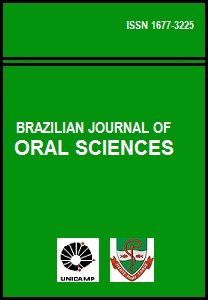Abstract
The occlusal surface has been considered the most suitable site for carious attack for its complex anatomy and posterior location. These characteristics facilitate plaque accumulation and difficult clinical perception of visual changes on pits and fissures. Complementary diagnostic methods have been developed in order to achieve early and individualized diagnosis, as well as to monitor carious lesions progression. The viability of these methods in clinical practice and their capacity in predicting activity and severity of caries are decisive factors in treatment planning. This literature review aims to gather information about the controversial issue of occlusal caries diagnosis and its treatment.References
Downer MC. The caries decline. A comment in light of the UK experience. Eur J Oral Sci 1996; 104: 433-5.
Marthaeler TM. The caries decline: a statistical comment. Eur J Oral Sci 1996; 104: 430-2.
Pine CM, Ten Bosch JJ. Dynamics of and diagnostic methods for detecting small carious lesions. Caries Res 1996; 30: 381-8.
Wang NJ. Variation in clinical time spent by dentist and dental hygienist in child dental care. Acta Odontol Scand 1994; 52: 280-9.
Lussi A. Comparison of different methods for the diagnosis of fissure caries without cavitation. Caries Res 1993; 27: 409-16.
Chan DCN. Current methods and criteria for caries diagnosis in North America. J Dent Educ 1993; 57: 422-6.
Barbachan e Silva B, Maltz M, Franco F. Diagnóstico e tratamento da cárie de superfície occlusal: variação entre examinadores. Rev Assoc Paul Cir Dent 1994; 48: 1231-4.
Ekstrand KR, Ricketts DNJ, Kidd EAM. Reproducibility and accuracy of three methods for assessment of demineralization depth on the occlusal surface: an in vitro examination. Caries Res 1997; 31: 224-31.
Verdonschot EH. Developments in caries diagnosis and their relationship to treatment decisions and quality of care. Caries Res 1999; 33: 32-40.
Pereira AC, Verdonschot EH, Huysmans MC. Caries detection methods: can they aid decision making for invasive sealant treatment? Caries Res 2001; 35: 83-9.
Longbottom C, Pitts NB. CO2 laser and the diagnosis of occlusal caries: in vitro study. J Dent 1993; 21: 234-9.
Eckert SE, Goldstein GR, Koka S. How to evaluate a diagnostic test. J Prosthet Dent 2000; 83: 386-91.
Nyvad B, Machiulskiene V, Baelum V. Reliability of a new caries diagnostic system differentiating between active and inactive caries lesions. Caries Res 1999; 33: 252-60.
Huysmans M, Longbottom C, Pitts NB. Electrical methods in occlusal caries diagnosis: an in vitro comparison with visual inspection and bitewing radiography. Caries Res 1998; 32: 324-9.
Thylstrup A. When is caries caries, and what should we do about it? Quintessence Int 1998; 29: 594-604.
Ekstrand KR, Bruun G, Bruun M. Plaque and gingival status as indicators for caries progression on approximal surfaces. Caries Res 1998; 32: 41-5.
Bader JB, Brown JP. Dilemas in caries diagnosis. J Am Dent Assoc 1993; 124: 48-50.
Elderton RJ. Assessment and clinical management of early caries in young adults: Invasive versus non-invasive methods. Br Dent J 1985; 158: 440-4.
Ekstrand KR, Qvist V, Thylstrup A. Light microscope study of the effect of probing in occlusal surfaces. Caries Res 1987; 21: 368-74.
Weerheijm KL. Occlusal ‘hidden caries’. Dent Update 1997; 24: 182-4.
Machiulskiene V, Nyvad B, Baelum V. A comparison of clinical and radiographic caries diagnosis in posterior teeth of 12- year-old Lithuanian children. Caries Res 1999; 33: 340-8.
Hintze H, Wenzel A, Jones C. In vitro comparison of D- and E-speed film radiography, RVG, and Visualix Digital Radiography for the detection of enamel approximal and dentinal occlusal caries lesions. Caries Res 1994; 28: 363-7.
Espelid I, Tveit AB, Fjeltveit A. Variations among dentists in radiographic detection of occlusal caries. Caries Res 1994; 28: 169-75.
Van Amerongen JP, Van Amerogen-Pieko A, Penning C. Validity of caries diagnosis in molars with discolored fissures by radiography. J Dent Res 1993; 72: 344.
Lazarchik DA, Firestone AR, Heaven TJ, Filler SJ, Lussi A. Radiographic evaluation of occlusal caries: effect of training and experience. Caries Res 1995; 29: 355-8.
Heaven TJ, Firestone AR, Weems RA. The effect of multiple examinations on the diagnosis of approximal caries and the restoration of approximal surfaces. Oral Surg Oral Med Oral Pathol Oral Radiol Endod, 1999; 87: 386-91.
Abbott P. Are dental radiographs safe? Austr Dent J 2000; 45(3): 208-13.
Côrtes DF, Ekstrand KR, Elias-Boneta AR, Ellwood RP. An in vitro comparison of the ability of fibre-optic transillumination, visual inspection, and radiographs to detect occlusal caries and evaluate lesion depth. Caries Res 2000; 34: 443-7.
Lussi A, Imwinkelried S, Pitts NB, Longbottom C, Reich E. Performance and reproducibility of a laser fluorescence system for detection of occlusal caries in vitro. Caries Res 1999; 3: 261-6.
Shi X-Q, Welander U, Angmar-mansson B. Occlusal caries detection with KaVo DIAGNOdent and radiography: an in vitro comparison. Caries Res 2000; 34: 151-8.
Schulte A, Gente M, Pieper K. Post eruptive changes of electrical resistance values in fissure enamel of premolars. Caries Res 1999; 33: 242-7.
Ashley PF, Ellwood RP, Worthington HV, Davies RM. Predicting occlusal caries using the Electronic Caries Monitor. Caries Res 2000; 34: 201-3.
Stookey GK, Gonzalez-Cabezas C. Emerging methods of caries diagnosis. J Dent Educ 2001; 65: 1001-6.
Vehkalahti M, Tarkkonen L, Varsio S, Heikillä P. Decrease in and polarization of dental caries occurrence among child and youth populations, 1976-1993. Caries Res 1997; 31: 161-5.
Mertz-Fairhurst EJ, Curtis Jr JW, Ergle JW, Rueggeberg FA, Adair SM. Ultraconservative and cariostatic sealed restorations: results at year 10. J Am Dent Assoc 1998; 129: 55 66.
Ricketts DNJ, Kidd EAM. Hidden caries: What is it? Does it exist? Does it matter? Int Dent J 1997; 47: 259-65.
The Brazilian Journal of Oral Sciences uses the Creative Commons license (CC), thus preserving the integrity of the articles in an open access environment.

